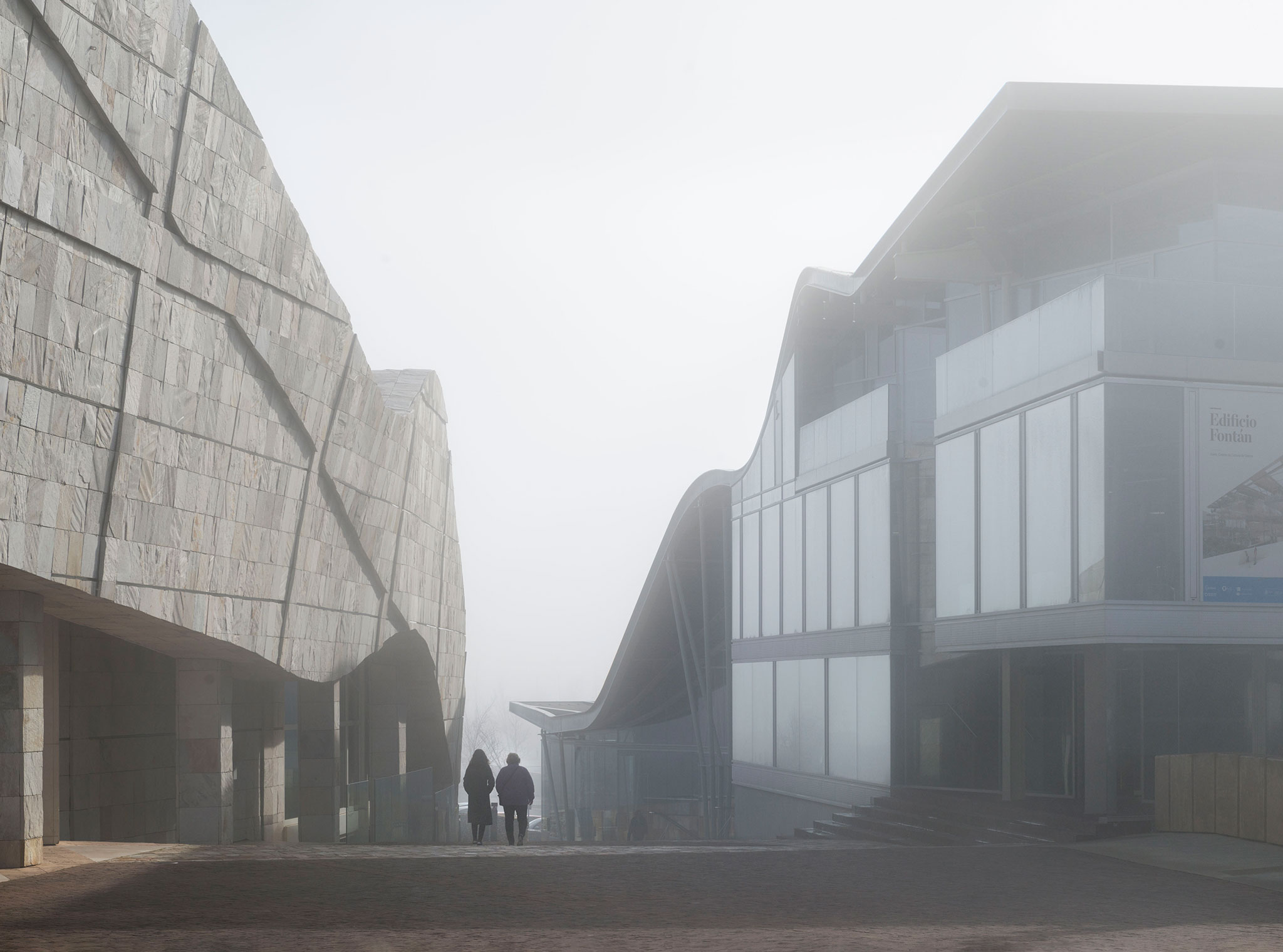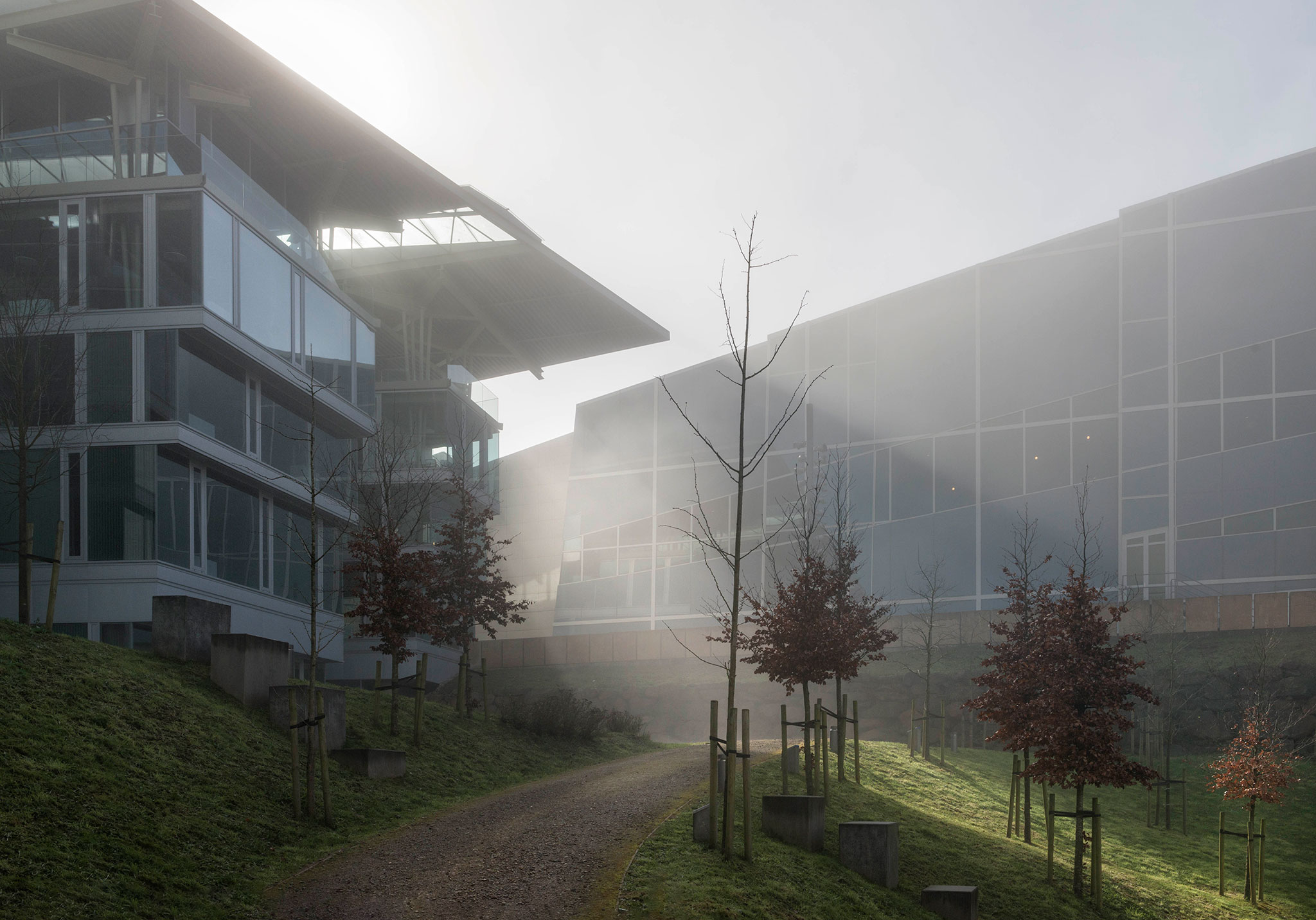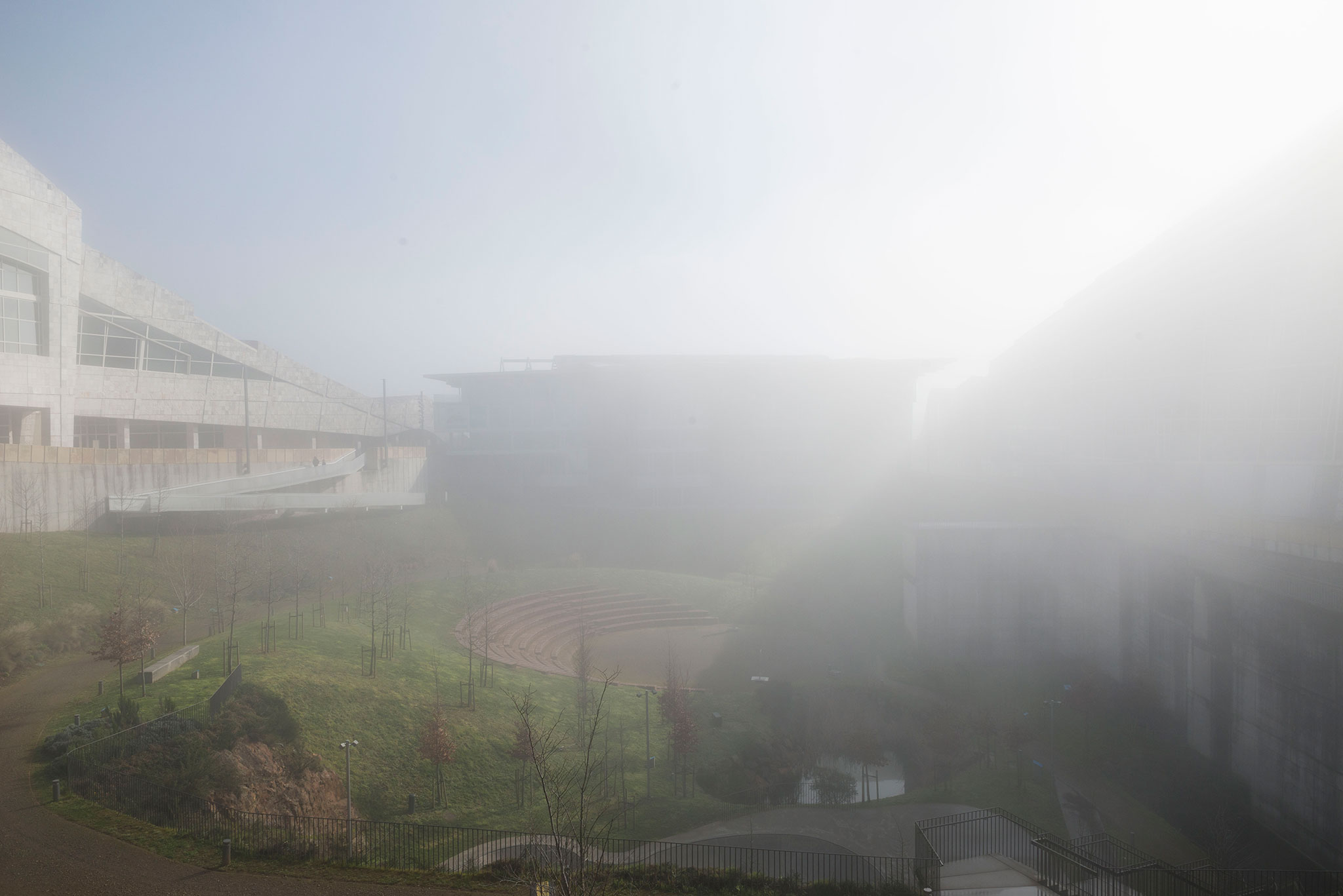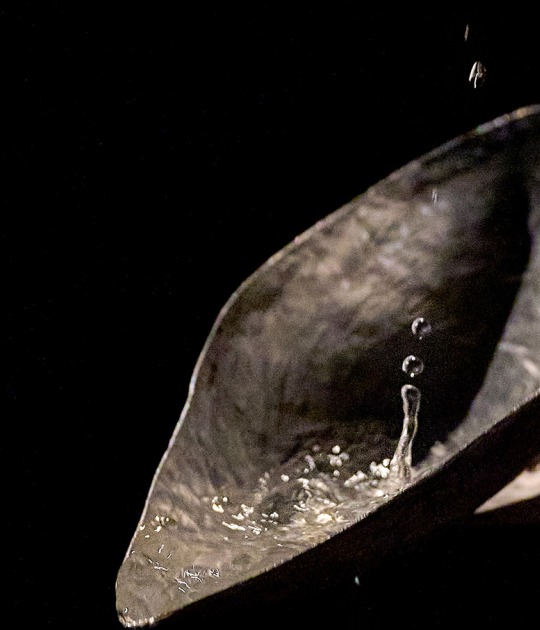I have always believed that limits help creation. The absence of constraints is an added problem because before getting started, you have to imagine how to start. That famous fear of the blank canvas.
What I did this time, as I usually do in these cases, after having tasted the bitterness of being blocked many times, was simply to go for it, even if it was with the fear that, having no conditions, I would run the risk of talking too much about myself in my photos, instead of talking about the architecture of the Fontán.
The meeting with Andrés Perea in person was the flashpoint. He looked at me with the attention that came from afar, attention of the horizon. He didn't ask anything of me but took it for granted. I felt as if he had painted me in his color. It sounds epic, but that's how his message came to me and made me take a stand.
I had data, the pre-existences, and a highly complex context surrounding the building, which could blur the camera lens. So I decided, on the one hand, to start before falling into the state of going around in circles, and on the other, to try to follow what I call "love at first sight."
It has happened to all of us that sometimes we remember the first time we saw (in situ, not in images created by others) an architectural work, and precisely those mental images that have stayed with us are usually partial, imperfect views, coming from a narrow street, overshadowed by other buildings, trees, or by arriving at the place from a road that is at a lower level, and you begin to glimpse the work from afar, only from the top, or one side...

Fontán building by Andrés Perea, Elena Suárez, Rafael Torrelo. Photograph by Ana Amado. Photographic selection by Ana Amado.

Fontán building by Andrés Perea, Elena Suárez, Rafael Torrelo. Photograph by Ana Amado. Photographic selection by Ana Amado.
I believe that this first image, when it is a work that we will later love, is the image of love at first sight. In the process of my photographic reportage, I always try to keep it in mind because it often contains the distilled essence of the work.
In the case of Fontán, this image occurred on the morning of the group visit. With all the authors of the texts that would make up the book together with my photos, different members who took part in the work, and the team behind the project: Andrés Perea with his partners Elena Suárez and Rafael Torrelo.
I liked the determination of the project's editorial team to involve us in this way, helping us to look in order to be able to talk afterwards, through a calm, relaxed and commented visit to the building, while the place itself was singing its own particular song in the ear of each one of us. In these times in which everything is for the day before yesterday, and where sometimes it is necessary to deal with painful virtuality, this ceremonious walk was like inhabiting a parallel reality, charged with inspiration.
I go back to that first image. I arrived before the others. The light was magical: a very bright morning but with a very thick fog, which was melting fast due to the action of the sun's rays. The first image I remember is the irregular gorge between the Fontán and the Eisenmann building filled with fog. However, the image that has stayed with me is the silhouette of the building towards the large scenic garden behind, emerging from the fog like a large ship. I took as many photos as I could, marveling, at the few minutes it took for the fog to dissipate, but I will never forget that presence, which reminds me so much of Andrés Perea's gaze.

Fontán building by Andrés Perea, Elena Suárez, Rafael Torrelo. Photograph by Ana Amado. Photographic selection by Ana Amado.
His memory accompanied me throughout the days I spent at the Fontán working. I enjoyed it and sweated, as happens with good commissions. Sometimes he made it easy for me, as when I wandered through those corridors of the fingers of light, which, like a great hand, stretched out in search of views of the garden. I enjoyed it there, trying to disturb them, to make those marvelous panoramas imperfect, sieved, hidden at times, at others extolling them in pictorial symmetries that constantly reminded me of Bosch's paintings.
I was also very amused to see how the Fontán filtered everything around it in its studied transparency, giving back a better, friendlier image. And then, if you turned around, you found yourself in the great passageway, where you could look out and see all those sincere and technological, geometric, zigzagging guts of strings and lights, reflections, dialogues of frames, color, and textures.
I just missed some more human action because the building was not yet in full use, and I am irremediably attracted to the dance between architecture and the human figure. "Architecture as the scene of our lives," as Zevi would say.
At that time, many offices and areas of the Fontán had not yet been inhabited. So the contamination of the human, of its skin, its manners, and moods, were still missing. In a later meeting with Andrés and his partners and friends, much more informal and with a few good gin and tonics between us, while we talked about love, cinema, promoters, Italy, and other things that are not relevant, he pointed out to me this point, important to round off the book that would tell the story of the Fontán.
I hope then to be able to look at his work again from another point, further away but closer at the same time, to mingle with its inhabitants, with the reality of a vibrant, busy building, and to photograph it again.
If only to meet Andrés again and continue talking - well - about architecture.
What I did this time, as I usually do in these cases, after having tasted the bitterness of being blocked many times, was simply to go for it, even if it was with the fear that, having no conditions, I would run the risk of talking too much about myself in my photos, instead of talking about the architecture of the Fontán.
The meeting with Andrés Perea in person was the flashpoint. He looked at me with the attention that came from afar, attention of the horizon. He didn't ask anything of me but took it for granted. I felt as if he had painted me in his color. It sounds epic, but that's how his message came to me and made me take a stand.
I had data, the pre-existences, and a highly complex context surrounding the building, which could blur the camera lens. So I decided, on the one hand, to start before falling into the state of going around in circles, and on the other, to try to follow what I call "love at first sight."
It has happened to all of us that sometimes we remember the first time we saw (in situ, not in images created by others) an architectural work, and precisely those mental images that have stayed with us are usually partial, imperfect views, coming from a narrow street, overshadowed by other buildings, trees, or by arriving at the place from a road that is at a lower level, and you begin to glimpse the work from afar, only from the top, or one side...

Fontán building by Andrés Perea, Elena Suárez, Rafael Torrelo. Photograph by Ana Amado. Photographic selection by Ana Amado.

Fontán building by Andrés Perea, Elena Suárez, Rafael Torrelo. Photograph by Ana Amado. Photographic selection by Ana Amado.
I believe that this first image, when it is a work that we will later love, is the image of love at first sight. In the process of my photographic reportage, I always try to keep it in mind because it often contains the distilled essence of the work.
In the case of Fontán, this image occurred on the morning of the group visit. With all the authors of the texts that would make up the book together with my photos, different members who took part in the work, and the team behind the project: Andrés Perea with his partners Elena Suárez and Rafael Torrelo.
I liked the determination of the project's editorial team to involve us in this way, helping us to look in order to be able to talk afterwards, through a calm, relaxed and commented visit to the building, while the place itself was singing its own particular song in the ear of each one of us. In these times in which everything is for the day before yesterday, and where sometimes it is necessary to deal with painful virtuality, this ceremonious walk was like inhabiting a parallel reality, charged with inspiration.
I go back to that first image. I arrived before the others. The light was magical: a very bright morning but with a very thick fog, which was melting fast due to the action of the sun's rays. The first image I remember is the irregular gorge between the Fontán and the Eisenmann building filled with fog. However, the image that has stayed with me is the silhouette of the building towards the large scenic garden behind, emerging from the fog like a large ship. I took as many photos as I could, marveling, at the few minutes it took for the fog to dissipate, but I will never forget that presence, which reminds me so much of Andrés Perea's gaze.

Fontán building by Andrés Perea, Elena Suárez, Rafael Torrelo. Photograph by Ana Amado. Photographic selection by Ana Amado.
His memory accompanied me throughout the days I spent at the Fontán working. I enjoyed it and sweated, as happens with good commissions. Sometimes he made it easy for me, as when I wandered through those corridors of the fingers of light, which, like a great hand, stretched out in search of views of the garden. I enjoyed it there, trying to disturb them, to make those marvelous panoramas imperfect, sieved, hidden at times, at others extolling them in pictorial symmetries that constantly reminded me of Bosch's paintings.
I was also very amused to see how the Fontán filtered everything around it in its studied transparency, giving back a better, friendlier image. And then, if you turned around, you found yourself in the great passageway, where you could look out and see all those sincere and technological, geometric, zigzagging guts of strings and lights, reflections, dialogues of frames, color, and textures.
I just missed some more human action because the building was not yet in full use, and I am irremediably attracted to the dance between architecture and the human figure. "Architecture as the scene of our lives," as Zevi would say.
At that time, many offices and areas of the Fontán had not yet been inhabited. So the contamination of the human, of its skin, its manners, and moods, were still missing. In a later meeting with Andrés and his partners and friends, much more informal and with a few good gin and tonics between us, while we talked about love, cinema, promoters, Italy, and other things that are not relevant, he pointed out to me this point, important to round off the book that would tell the story of the Fontán.
I hope then to be able to look at his work again from another point, further away but closer at the same time, to mingle with its inhabitants, with the reality of a vibrant, busy building, and to photograph it again.
If only to meet Andrés again and continue talking - well - about architecture.
Text by Ana Amado.
































